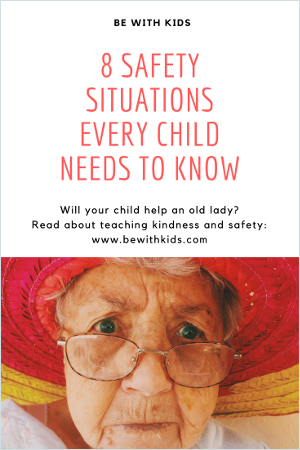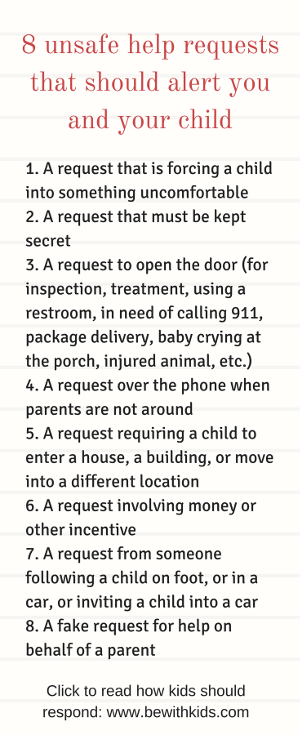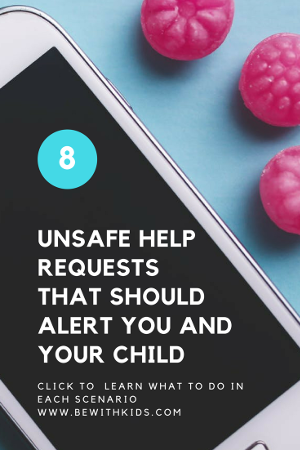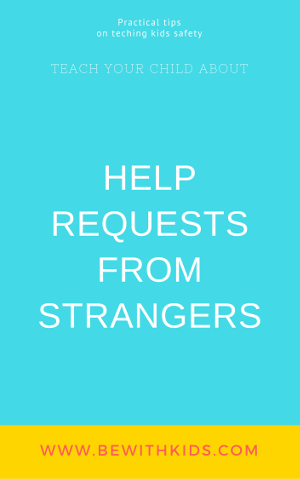8 unsafe help requests from strangers that should alert you and your child
A stranger is asking a child for help
This is the second part of the series "Help requests from strangers". Read the first part here: "A stranger is asking a child for help".
When your child turns 3 years old teach them:
- The difference between safe and unsafe help requests
- How to behave to be kind and stay safe
- What to do if they find themselves in a situation you haven’t discussed yet (for example, if a good-looking old lady is asking for something and you didn’t talk about it)

How your child is responding to a help request
- Shall I go ahead and help?
- Shall I walk away?
- Am I rude and unsympathetic?
It's hard.
Most of the time we encourage our kids to cooperate, answer questions, be nice, polite, and cute.
That's why today we will talk about a very important and commonly neglected skill: Rejection.
Right to reject
By the school age your child needs to learn:
- How to reject firmly and politely
- How to say "No" to a grown-up
- How to express his disagreement, dislike, or unwillingness to participate in something
This is the cornerstone of his ability to stand up for:
- his boundaries,
- his physical and emotional space, and
- his interests and opinions
Three weak spots predators are looking for
These are the most common buttons pushed by predators to manipulate a child:
- Significance: feeling important and involved.
- Curiosity: luring surprises, adventures, or unknown things.
- Being a helper: when your child sees a kitten, a puppy, or someone helpless, old, little, sick, or otherwise in need of help.
These triggers throw children into an unusual and disruptive situation.
What happens to unprepared kids
- Most strangers who ask your child for help do it with good intentions (hoping they will help to build good character, for example) or without thinking much at all.
- The line between good people and those with bad intent is very subtle for the child.
- Harmful people are well-prepared and aware of a child’s psychology. They know and use tricks.
! Unprepared kids cannot figure out when a help request might have bad intentions.
8 scenarios your child must know by kindergarten
Make sure you've discussed all these scenarios and what to do - because they should raise a huge red flag in your child's mind:
- A request that is forcing a child into something uncomfortable
- A request that must be kept secret
- A request to open the door (for inspection, treatment, using a restroom, in need of calling 911, package delivery, baby crying on the porch, injured animal, etc.)
- A request over the phone when parents are not around
- A request requiring a child to enter a house, a building, or move into a different location
- A request involving money or other incentives
- A request from someone following a child on foot, or in a car, or inviting a child into a car
- A fake request for help on behalf of a parent
(If you feel this topic is important, pin this list for other parents, please):

What kids should do in each situation?
Download the instructions
↓↓↓↓↓↓↓
- How to recognize unsafe requests
- How to behave
- How to help safely or reject properly
In a positive, non-scary way.

P.S. If your child learns how to help and reject to help properly when he is little, not only he will be much safer when communicating with strangers, but he will also have higher self-esteem and lower risk of being involved in trouble during the teenage and adult years.
Don’t wait until it is too late.
↑↑↑↑↑↑↑
Take action
Great job so far - safety is a challenging subject!
Please sign up above to see the next steps.
↑↑↑↑↑↑↑
Can't find what you are looking for?
Please tell me what you are looking for and how I can help.
I'll be in touch.
Or try using the 




